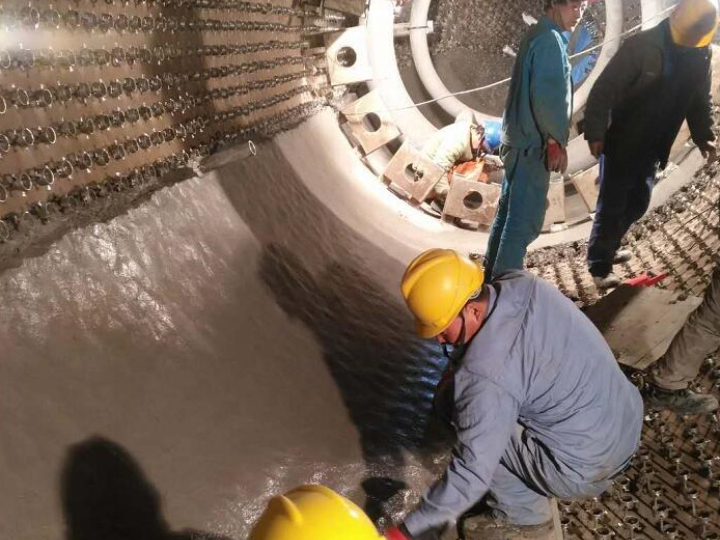Umu Sima Whakawhanui Hoahoa Hononga Hangahanga me nga Rauemi Refractory
During the first heating process of cement kiln construction, refractory castables will shrink twice in volume, when dehydrating at 50℃~200℃ and sintering at 900℃~1000℃. In other temperature ranges, heating will cause the castable to expand. After the first heating, the castable generally no longer shrinks.
To prevent the stress caused by volume change from damaging the castable, the lining must be divided into small areas with a diagonal size of no more than 1.5m, the area must be poured and a gap for expansion and contraction must be left at the boundary of each pouring area.

Influence range of expansion joints
The size of the gap in cement kiln construction should ensure the free expansion of the castables in each area. The expansion joints with appropriate positions can also serve as control joints. In the high-temperature section (>600℃), the width of the expansion joints should be controlled at 3-4mm according to the spacing of the expansion joints. The expansion joints and control joints are set on the plane about 200mm away from the convex corners, rather than in the convex corners and the pointed cones. The castables on both sides of the expansion joints and control joints have a greater tendency to crack, and the density of the nails can be appropriately increased.
How to set the width of cement kiln expansion joints?
The width of the expansion joint in cement kiln construction is related to the working temperature and the controlled line length. When the temperature is high and the controlled length is long, the expansion joint can be appropriately widened. In relatively low-temperature areas (<400℃), the equipment shell can be directly castable without thermal insulation. Under such conditions, inserting 2mm thick cardboard or plastic film every 1.5m can meet the expansion space requirements.

Cement kiln expansion joint location
When determining the expansion position during cement kiln construction, the reasonable arrangement of the vibration process should be considered at the same time. The vibration of the castable on one side of the gap should not affect the castable that has been poured and vibrated and has begun to harden. The location of the expansion joint avoids the stress-bearing parts, the holes of the furnace frame, and the lining. In areas with complex shapes, such as corners, protrusions, etc., expansion joints that are adapted to their surfaces should be set at protruding angles and curved surfaces with small curvature radii, when two casting surfaces intersect to form a concave angle, an L-shaped expansion joint should be set at the concave angle.
In the design drawings, the lining diagram should show the location and size of the expansion joints in the main parts. If the working temperature of the castable exceeds 1200℃, an expansion joint with a width of more than 3mm should be set and fiber felt should be stuffed into it.
The setting of control joints

During cement kiln construction, castables will crack due to shrinkage, so control joints need to be set at about 200mm at the convex corners, so that shrinkage cracks can occur in predetermined and safer locations. Control joints can be set by stuffing paper, paraffin, or thin wood boards into the predetermined gaps, and casting combustible or runoff materials under high-temperature conditions. After these combustibles burn or runoff, control joints are left. During cement kiln construction, control joints must be set between adjacent nails, and the distance from the nails on both sides is roughly equal. When set on continuous curved surfaces, conical surfaces ,and pipes, they should be set on planes and curved surfaces where the risk of shrinkage cannot be controlled. It should be avoided to set expansion joints in areas where expansion joints cannot be set, such as setting expansion joints on small casting surfaces and convex corners.
 Rongsheng Refractory Factory
Rongsheng Refractory Factory
WeChat
Matawai te Waehere QR me te wechat